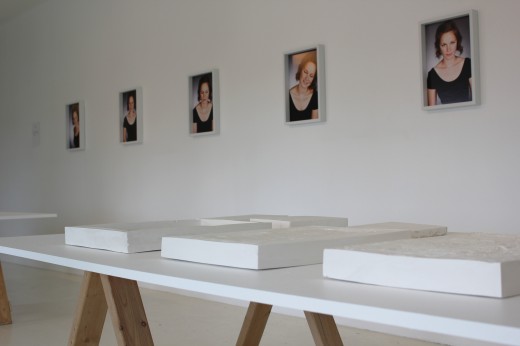Tatiana Vahan, A Narrative of An Artist Exploring Capitalism
Hunter Braithwaite

March 27th – May 4th, 2014
It’s not an accident that the first syllable of bildungsroman—the type of book focused on the maturation of some kid like Goethe’s Young Werther or Joyce’s Stephen Daedalus as a formative process: one of construction, of making—sounds like “building.” Here, Tatiana Vahan presents two narratives—the formation of the artist, and the formation of a series of objects—through the warped lens of contemporary life and capitalism, suggesting perhaps that they are made in similar fashions.
One narrative unfolds as an episodic biography of Vahan, described in the series of press release/wall text hybrids accompanying select works as “an artist.” She has opted for the indefinite article, a strange distancing effect that is almost parabolic. In the first room, one finds “A Narrative of An Artist Exploring Capitalism, Part III, 1998 – 2014.” The text reads: “In 1998, at the age of fifteen, an artist acquired her first legitimate job as a “sandwich artist” at the highest grossing Subway sandwich shop in the United States, located in a strip mall in Kendall, a sprawling suburb in unincorporated Dade County. She worked there for six months.” Next to the text is Vahan’s completed application—an earnest application to earn an honest dollar as a sandwich artist®, but made absurd when you see her former employers as Andrea Zittel and François Ghebaly.
On the floor is a thigh-high stack of 10,000 Subway applications, an unexpected baring of influences. Of course it’s paperwork, it’s labor, but it’s also Félix González- Torres, and with that, the de la Cruz collection, and Vahan’s growing up in Miami and BFA from New World. She’s wearing her influences on her sleeve, but then again, such is youth.
The next room contains the second part of Vahan’s narrative. In 2004, the text reads, “an artist stole a bottle of wine from a gas station in Key Biscayne, Fl.” If private property is theft, then theft is, at least in the state of Florida, public domain. Vahan’s mugshot from the shoplifting incident was posted on the website Bustedmugshots.com. Enlarged versions are on the gallery, her spritely face a pixelated Rimbaud by way of Bonnaroo. Two have been defaced—scraped with one of the three found scraps of sculpture found in her studio that make up “The Magic Mountain”. The title of the sculpture, a reference to Thomas Mann novel in which the young protagonist spends seven bildungsjahre in an alpine sanatorium. But beyond the titular connection to the exhibitions’ theme, one struggles to place the objects as pieces of art or as symbols of discourse.











